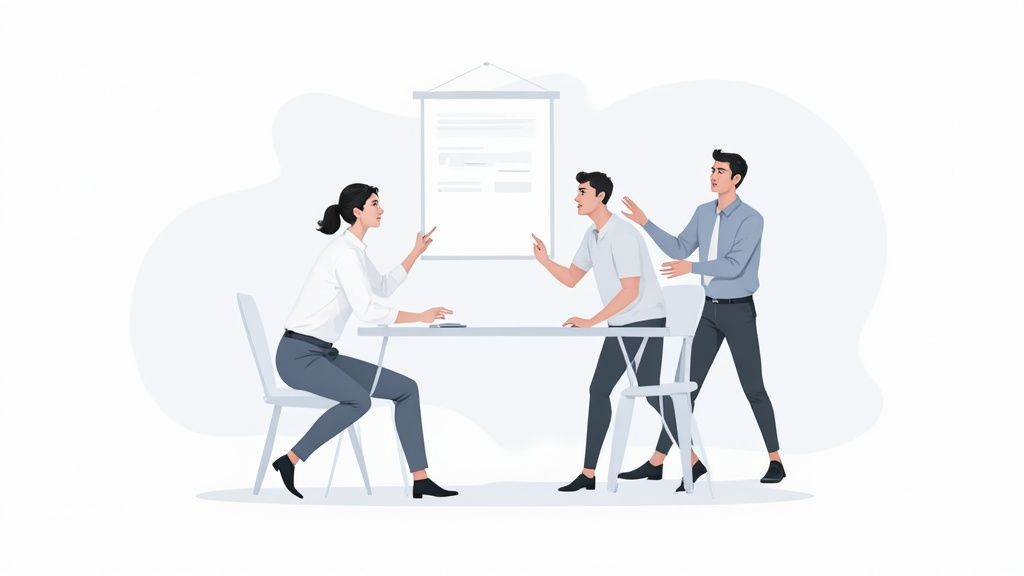The Unmistakable ROI of Employee Development Programs
Employee development programs are often viewed as a substantial investment for any organization. This naturally leads to questions about their effectiveness and return on investment. The answer is a resounding yes. Well-designed programs directly contribute to a healthier bottom line. These initiatives are not simply an HR function; they are a strategic tool for better performance, higher profits, and a more engaged workforce. So, how can we measure this return?
Measuring The Tangible Impact
One of the strongest arguments for employee development lies in the measurable improvements they bring. Companies prioritizing development often outperform their competition in key areas like productivity and employee retention. This isn't a coincidence. It's a direct result of investing in employee growth. These programs provide employees with the skills and knowledge they need to excel, resulting in greater efficiency and higher quality work.
This brings us to another crucial metric: profitability. Employee development programs aren't just about individual performance; they contribute to the overall financial well-being of the company. Increased productivity directly translates into higher revenue and profits. Furthermore, these programs create a culture of learning and growth, increasing employee morale and job satisfaction, which, in turn, reduces costly employee turnover.
The effect on productivity and profitability is substantial. Studies indicate companies offering training see a 17% increase in productivity and a 21% boost in profitability, particularly when employees are engaged. However, with only 15% of full-time workers reporting high engagement, the need to maximize the impact of training programs is clear. Companies investing in training can more than double their income per employee compared to those that don't. For more in-depth statistics, see Devlin Peck's research on employee training statistics.
To further illustrate the financial benefits of employee development programs, let's look at a comparison:
To illustrate this further, let’s consider the following table summarizing the ROI of such initiatives.
The table below compares key business metrics between companies that invest in employee development and those that don't.
ROI of Employee Development Programs
Metric | Companies With Development Programs | Companies Without Development Programs | Percentage Difference |
|---|---|---|---|
Productivity | 117 units | 100 units | +17% |
Profitability | 121 units | 100 units | +21% |
Employee Retention | 90% | 75% | +15% |
Revenue per Employee | $200,000 | $100,000 | +100% |
As this table clearly shows, companies with robust development programs significantly outperform their counterparts in key areas. This reinforces the idea that investing in employees is a direct investment in the company’s success.
From Skepticism To Advocacy: Demonstrating Value
Many executives initially express reservations about the cost of these programs, questioning their return on investment. This is understandable. However, this skepticism can be addressed by showcasing the direct link between development initiatives and tangible results. By monitoring key performance indicators (KPIs) before, during, and after program implementation, companies can demonstrate the impact of these programs on productivity, profitability, and employee retention.
This data-driven approach reframes the conversation from cost to investment. When executives see tangible evidence of how these programs contribute to the bottom line, they become advocates for further investment. This creates a positive feedback loop, with increased investment leading to even greater returns. Ultimately, a well-structured program improves ROI and cultivates a culture of growth and continuous improvement.
Building Development Programs That Actually Work

What separates truly effective employee development programs from the rest? Success hinges on a solid foundation of planning, authentic leadership support, and a commitment to continuous improvement. Let's delve into the key components of impactful development initiatives.
Needs Assessment and Alignment
Creating a valuable program starts with understanding employee needs and organizational goals. A needs assessment should go beyond simply asking employees what they want. It involves analyzing performance data, identifying skill gaps, and anticipating the future direction of the business. This ensures individual aspirations align with the company's strategic objectives, contributing directly to overall success.
Securing Leadership Buy-In
Leadership support is essential for any employee development program to flourish. This requires more than just budget approval; it demands active participation and visible commitment from leaders at every level. Leaders can demonstrate their commitment through mentoring, participating in training themselves, and consistently emphasizing the importance of development. This fosters a culture that values learning and growth.
Creating a Safe Learning Environment
A psychologically safe learning environment is paramount. Employees need to feel comfortable taking risks, asking questions, and even making mistakes. This environment nurtures open communication, encourages feedback, and promotes experimentation. It cultivates a sense of value and respect, boosting motivation and leading to a more engaged workforce.
Resource Allocation and Commitment
Investing in employee development is a significant and ever-evolving financial commitment. The global workplace training market was projected to reach nearly $401 billion by 2024. In 2022, US businesses spent $101.6 billion on training, averaging around 62 hours per employee annually. Many organizations are increasing their training budgets by 6% to 15%. For a deeper dive into these figures, explore Statista's workplace learning and development research. This underscores the growing recognition of employee development as a strategic investment.
Blending Formal and Informal Learning
The most effective programs combine formal training with informal learning opportunities. These include mentoring, challenging assignments, and regular feedback. This blended approach provides a more well-rounded experience, allowing employees to apply their knowledge in practical settings with ongoing support. For example, combining project management training with a challenging project, along with mentorship from a senior project manager, can significantly accelerate skill development. This integrated approach fosters lasting behavior change and performance improvement, benefiting both the individual and the organization.
Crafting Learning Journeys That Transform Careers

Generic employee development programs often miss the mark in today's diverse workplaces. Instead of mandatory exercises, successful organizations are building personalized learning pathways that truly resonate with employees and foster meaningful growth. These programs are seen as opportunities, not obligations.
Identifying Individual Skill Gaps
Effective development starts with understanding individual needs. This goes beyond simple self-assessment. Leading organizations use a multi-faceted approach. They combine self-reflection with manager input and actual performance data.
For example, a manager might observe an employee struggling with client presentations. This observation, combined with the employee's desire to improve communication skills, provides valuable insight. Adding performance analytics to the mix creates a clear picture of areas ripe for growth. This ensures resources are focused where they'll have the greatest impact.
Adaptive Learning Technologies
Once skill gaps are identified, the focus shifts to providing personalized learning. This is where adaptive learning technologies shine. These technologies go beyond generic content, tailoring the experience to each employee's progress and specific needs.
Think of it as a personal tutor who adjusts their approach based on the student's understanding. As the employee learns and grows, the technology adapts. It might introduce more challenging material or concentrate on areas where the employee is struggling. This personalized approach boosts engagement and motivation, resulting in better outcomes.
Balancing Customization and Scalability
Personalized learning doesn't have to overwhelm L&D teams. The key is balancing customization with scalability. This often involves using technology to automate aspects of the process, such as content delivery and progress tracking.
However, the human element remains essential. Managers play a vital role in providing personalized coaching and support. This blend of technology and human interaction creates development experiences that are both personally relevant and manageable. A platform with personalized learning recommendations, combined with regular manager check-ins, can be a highly effective approach.
Connecting Growth to Organizational Needs
Finally, effective programs align individual growth with overall company goals. This means connecting individual development plans to the organization's strategic objectives. As employees grow, they directly contribute to the company's success.
This creates a win-win. Individual aspirations and organizational needs become mutually reinforcing. This strong connection between individual growth and organizational success makes employee development a key driver of business performance. By fostering a culture of continuous improvement and aligning learning with organizational strategy, companies create a competitive edge by investing in their people.
Embracing Technology That Enhances Human Learning

Effective employee development programs are no longer limited to traditional classrooms or static learning management systems (LMS). Technology offers a range of dynamic tools that can reshape learning experiences and make them truly impactful. Forward-thinking organizations are adopting these tools to encourage growth, boost engagement, and enhance skill development.
Integrating Microlearning Platforms
One powerful approach is using microlearning platforms. These platforms deliver short, focused bursts of learning content that easily integrate into employees' daily workflows. This approach helps combat information overload and makes learning more digestible and convenient.
For example, instead of long training modules, employees might access short videos or interactive exercises on specific topics via their smartphones or computers. This allows them to immediately apply new knowledge, reinforcing their learning and making it relevant to their current tasks.
The Power of Immersive Simulations
Another valuable tool is immersive simulations. These simulations create realistic scenarios, allowing employees to practice new skills in a safe, controlled environment. Imagine a pilot using a flight simulator to refine skills without real-world risk.
Similarly, sales representatives might use a simulation to practice handling difficult client interactions. This method accelerates skill mastery and builds confidence by providing a risk-free space for experimentation and learning from mistakes.
Mobile Learning for Accessibility
Mobile applications have changed how we access information, and employee development is no different. Mobile learning apps provide development opportunities anytime, anywhere. This flexibility benefits employees who travel frequently, work remotely, or have limited time for traditional training.
These apps can deliver bite-sized learning modules, provide access to resources, and even encourage collaboration and peer-to-peer learning.
Prioritizing User Experience
Choosing the right technology is crucial. Leading companies prioritize user experience over extensive features when selecting development tools. This focus ensures high adoption rates and meaningful engagement.
A platform with a clunky interface, regardless of its features, is likely to be underutilized. A user-friendly platform, even with fewer features, encourages active participation and maximizes the program's benefits.
Learning Analytics for Continuous Improvement
Learning analytics offer valuable insights into program effectiveness. By analyzing data on employee progress, engagement, and knowledge retention, organizations can identify patterns and predict future skill gaps. This allows them to refine programs and ensure they're aligned with business objectives, leading to measurable results.
The key is using this data strategically. Focus on actionable insights rather than becoming overwhelmed. This means setting clear objectives for data analysis, selecting relevant metrics, and regularly reviewing the data to find areas for improvement.
By balancing technological innovation and human connection, organizations can create development programs with lasting results. This involves leveraging technology to personalize learning, provide ongoing support, and measure program effectiveness, while also maintaining human interaction, collaboration, and mentorship. This integrated approach fosters a culture of continuous learning and growth, empowering employees and driving organizational success.
Measuring Impact Beyond Completion Rates
Moving beyond simple metrics like course completion rates and satisfaction surveys is crucial for showcasing the true value of employee development programs. Organizations that prioritize growth understand that linking learning activities to tangible business outcomes is essential. This not only justifies the investment but also ensures program effectiveness. This means examining the impact on performance, productivity, and even the bottom line.
Frameworks for Evaluation
Evaluating the impact of these programs requires a multi-faceted approach. Consider these key areas:
- Learning Transfer: How well are employees applying new knowledge and skills in their daily work?
- Behavioral Change: Are the programs creating lasting changes in employee behavior and work habits?
- Business Impact: What's the measurable effect on key business metrics? Think productivity, efficiency, customer satisfaction, and revenue.
For example, a sales training program should ideally lead to increased sales conversions, not just positive feedback. This broader perspective offers a more accurate assessment of a program's real-world effectiveness.
Gathering Meaningful Data
Gathering effective data requires a variety of methods. Surveys, observations, performance analytics, and longitudinal studies each offer unique insights.
- Surveys: Gather feedback on program effectiveness and employee satisfaction.
- Observations: Directly observe employees to see if new skills are being implemented.
- Performance Analytics: Track key performance indicators before, during, and after the program. This data provides quantifiable evidence of progress.
- Longitudinal Studies: Monitor the long-term effects of the program on employee growth and business outcomes. These studies provide valuable insights into lasting change.
Combining qualitative and quantitative data provides a comprehensive understanding of the program's impact. This combination paints a more detailed and nuanced picture.
To help illustrate the key metrics organizations should track, consider the following table:
Key Metrics for Development Program Evaluation: Essential metrics across different evaluation dimensions that organizations should track to assess the effectiveness of their employee development programs.
Evaluation Category | Key Metrics | Data Collection Methods | Reporting Frequency |
|---|---|---|---|
Learning Transfer | Improved task completion time, Reduced errors, Increased application of new skills | Observations, Performance data analysis, Self-assessments | Monthly/Quarterly |
Behavioral Change | Increased collaboration, Improved communication, Enhanced problem-solving skills | 360-degree feedback, Supervisor evaluations, Peer reviews | Quarterly/Annually |
Business Impact | Increased sales, Improved customer satisfaction, Reduced costs, Higher profitability | Business performance data, Customer surveys, Financial reports | Annually |
This table summarizes the key metrics for each evaluation category, the data collection methods used, and how often these metrics should be reported. Tracking these metrics consistently allows organizations to measure the effectiveness of their development programs and make data-driven decisions.
Establishing Baselines and Tracking Systems
Before launching a development program, establish clear baseline measurements. This allows for comparison of pre- and post-program performance, demonstrating the initiative's impact.
Effective tracking doesn't require complex systems. Utilize existing performance management systems and integrate simple data collection methods. This keeps the tracking process streamlined and sustainable.
Communicating Results to Stakeholders
Communicating results effectively requires tailoring the message to the audience. While executives may focus on ROI, individual participants benefit from progress indicators. These indicators highlight individual growth and motivate continued learning. Tailor your communication to resonate with each specific audience.
Sharing employee success stories can powerfully demonstrate program impact and encourage participation. These stories humanize the data and make the benefits relatable. The goal is to foster a culture of continuous improvement. In this culture, employee development is seen as a valuable investment in both individual and organizational success. By adopting a comprehensive measurement approach, you can showcase the true value of employee development and secure support for continued investment.
Navigating Roadblocks to Development Success
Even the best employee development programs can hit a few snags along the way. This section tackles common challenges and offers practical solutions from learning leaders who have successfully overcome them. We'll explore strategies for securing funding, keeping the momentum going, and addressing the ever-present issue of limited time.
Overcoming Budget Constraints
Securing consistent funding for employee development can be tough, especially when budgets are tight. One effective strategy is to directly link development initiatives to business goals. Show how these programs contribute to increased productivity, reduced costs, or improved customer satisfaction. For example, if a company wants to improve customer retention, highlight how a customer service training program, like those offered by Mindflash, can equip employees with the skills they need to create better customer experiences. This data-driven approach strengthens the argument for continued investment.
Additionally, explore alternative funding models. Consider teaming up with other organizations to share program costs or look for grants focused on workforce development. These partnerships can make high-quality programs more affordable.
Maintaining Momentum Through Change
Leadership changes or restructuring can disrupt even well-established programs. To keep things moving, integrate development initiatives into the company culture. When development is a core value, it's more likely to withstand leadership transitions.
Document program successes and share them widely. This builds a track record of positive outcomes, making it harder to justify cuts during times of change. Also, involving employees in program design and implementation fosters ownership, ensuring sustainability regardless of leadership changes.
Addressing Time Scarcity
Limited time often hinders employee participation. One solution is to incorporate development into the workday. This could involve using microlearning platforms that deliver short bursts of training content or scheduling dedicated development time during team meetings. This integrated approach makes learning more manageable.
Another strategy is to offer flexible learning options. This could include online modules, self-paced courses, or blended learning programs combining online and in-person sessions. This flexibility accommodates various learning styles and schedules.
Converting Skeptical Managers
Some managers see development programs as a distraction from daily tasks. Address this by showcasing the direct benefits to their teams. For example, demonstrate how a leadership training program can empower team members to take on more responsibility, freeing up the manager's time.
Furthermore, involve managers in program selection and customization. When managers are part of the process, they become invested in the outcomes and are more likely to support employee participation.
Combating Program Fatigue
Initial enthusiasm for new programs can wane. To combat this, regularly evaluate and refresh program content. Get feedback from participants to identify areas for improvement and ensure materials stay relevant and engaging. For instance, incorporate new case studies, real-world examples, or interactive exercises.
Consider a gamified learning approach, incorporating elements like points, badges, and leaderboards. This friendly competition can boost engagement and motivate employees to actively participate.
By proactively addressing these common roadblocks, organizations can build thriving employee development programs that yield lasting results. These programs become essential for continuous improvement, fostering a culture of learning and positioning companies for success in a dynamic environment. Investing in employee development is investing in the future of your organization.
The Future of Employee Development Programs
As the nature of work continues to evolve, so too must the programs designed to develop employees. This section explores emerging trends shaping the future of talent development, focusing on how organizations are adapting to the changing needs of their workforce and the opportunities presented by new technologies. These changes signify a shift from traditional, one-size-fits-all training models to more personalized and dynamic learning experiences.
The Rise of Skills-Based Organizations
Many organizations are transitioning away from traditional job descriptions and toward a skills-based approach. This model emphasizes the specific capabilities employees possess rather than adhering to rigid job titles. Employee development programs play a critical role in this shift, helping individuals acquire new skills and adapt to evolving business needs.
This means development programs need to become more agile and personalized. They should offer a wide range of opportunities for employees to develop skills relevant to both their current roles and future career aspirations. This approach also allows organizations to adapt quickly to market changes by cultivating a workforce with diverse and adaptable skill sets.
Integrating Wellbeing With Professional Growth
Employee wellbeing is no longer a peripheral concern but an integral aspect of professional development. Future development programs will likely incorporate elements of mental and emotional wellbeing, recognizing the connection between a healthy employee and a productive employee.
This integration acknowledges the direct impact personal wellbeing has on professional performance. Programs that address stress management, work-life balance, and mindfulness can cultivate a more supportive and productive work environment.
Democratizing Learning Opportunities
Access to development shouldn't be limited by role or seniority. Progressive organizations are democratizing learning, making opportunities available to everyone, regardless of their position within the company. This approach fosters a culture of continuous growth and ensures that everyone has the chance to reach their full potential.
Democratization can be achieved through various methods including online learning platforms like Coursera, mentorship programs, and peer-to-peer learning initiatives. These easily accessible resources create a more equitable learning environment and maximize the development of the entire workforce.
AI-Powered Personalization and Prediction
Artificial intelligence (AI) is transforming employee development. AI algorithms can analyze large amounts of data to pinpoint individual skill gaps and recommend personalized learning paths. This tailored approach results in a more engaging and effective learning experience, catering to individual needs and maximizing skill development.
Moreover, AI can predict future skill requirements based on industry trends and organizational strategy. This allows organizations to proactively develop their workforce, preparing them for future challenges and ensuring they possess the necessary skills to succeed. This proactive, future-focused approach is essential in a dynamic business environment.
From Episodic Training to Continuous Development
Traditional episodic training models are being replaced by continuous, self-directed learning. Employees are empowered to take ownership of their development, pursuing learning opportunities that align with their personal interests and career goals, while still supporting the overall organizational strategy.
This shift emphasizes lifelong learning and encourages employees to continually hone their skills. It also empowers them to take charge of their career trajectories, creating a more engaged and motivated workforce. It’s a personalized learning journey, fueled by individual curiosity and guided by organizational needs.
Adapting to Remote and Hybrid Work
The increase in remote and hybrid work models calls for new approaches to employee development. Traditional classroom-based training often doesn't fit these settings. Programs need to be crafted to be accessible and engaging for remote workers, using online platforms like Zoom, virtual collaboration tools like Slack, and flexible learning formats.
This involves creating learning experiences that are not confined by physical location. Online platforms, virtual workshops, and mobile learning apps can ensure remote workers have the same development opportunities as their in-office colleagues. Focusing on accessibility is crucial for building inclusive and effective development programs in today's workplace.
Happily.ai supports continuous development by offering microlearning content personalized to the individual. By understanding the skills that would be most beneficial for employees to achieve their goals, Happily.ai generates personalized learning content integrated into the routine of checking in and feedback. Learn how Happily.ai can help you cultivate a thriving culture of continuous development at https://www.happily.ai.









